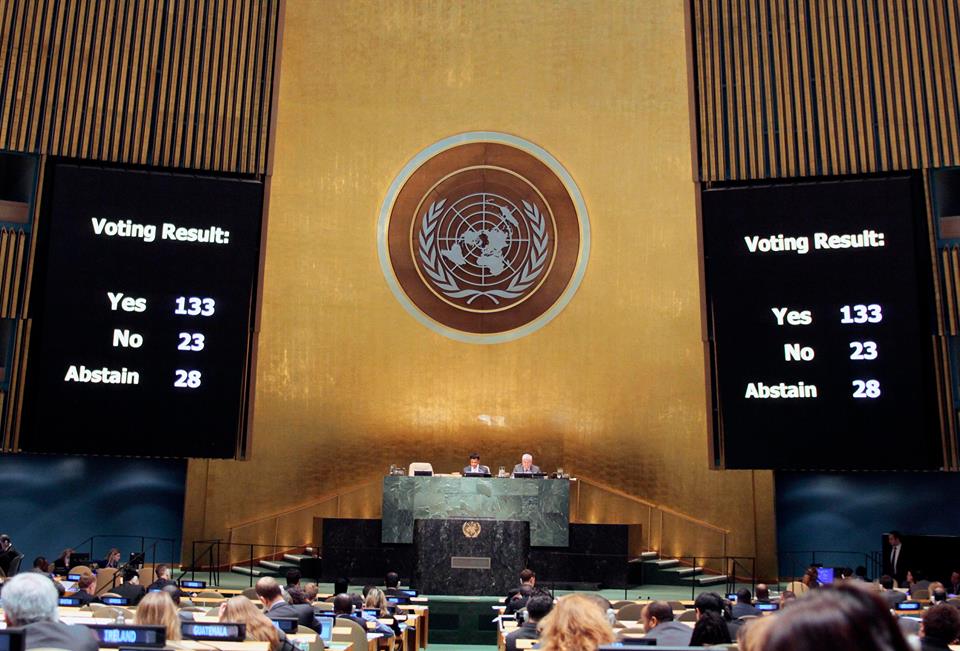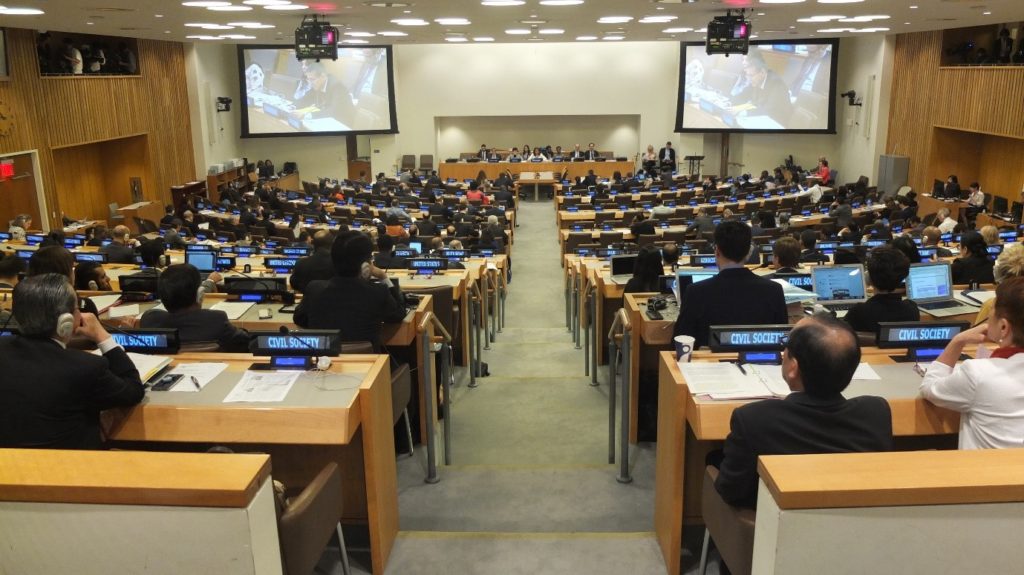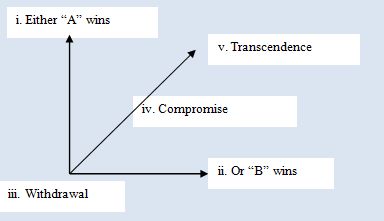A Call to Apply the TRANSCEND Method to the Middle East Conflict
EDITORIAL, 15 Jul 2019
#595 | Diane Perlman, PhD – TRANSCEND Media Service
Before the UN Conference on a Nuclear Weapons [WMD] Free Zone in the Middle East
In the spirit of TRANSCEND co-founder and friend Dieter Fischer, I’ll start with a joke. When Arafat and Rabin die they ask God, “When will there be peace in the Middle East?” God says, “Not in my lifetime.”
In 1995, after being asked when Israel will give up nuclear weapons, Former Israeli Prime Minister Shimon Peres said, “Give me peace, and we’ll give up the nuclear program. That’s the whole story.”
Current Israeli Prime Minister Benjamin Netanyahu said, “As far as a nuclear weapons-free zone, you know, when the lion lies down with the lamb, and you don’t need a new lamb every day to satisfy the lion, then we might have this kind of transformation in the Middle East.”
Understandably, many Israelis, with their earliest self-image as a tiny country surrounded by a sea of enemies (less accurate now) believe that without nukes Israel would not exist. Peres believed that even the perception, “in itself, can act as a deterrent.” He added: “Let them suspect. I don’t see any reason to allay their suspicions.”
Stumbling Blocks to a Middle East Nuclear-Weapon-Free Zone
After decades of controversy and opposition, there will finally be a UN Conference on a Middle East Nuclear-Weapon-Free Zone (MENWFZ) in New York, November 18 – 22, 2019.
Israel will not attend.
UN resolutions have called for a MENWFZ since 1974. In 1995, at the 25 year mark of the Nuclear Nonproliferation Treaty (NPT), it was granted an indefinite extension, calling for “the establishment of an effectively verifiable Middle East zone free of weapons of mass destruction, nuclear, chemical and biological, and their delivery systems.” with a commitment to hold a conference on a MENWFZ. The 2010 NPT Review Conference (RevCon), held every 5 years, adopted a plan of action including a conference on the establishment of a MENWFZ and all WMDs to be held in Helsinki in November of 2012. It didn’t happen.
At the end of the 4-week 2015 NPT RevCon at 9 o’clock on May 22, the last Friday night, delegates failed to reach consensus over the MENWFZ, opposed by the US, UK, and Canada. Virtually all NGO civil society representatives and most states parties were deeply disappointed and frustrated with the opposition to this conference, with no shortage of mutual blame.
The US supports other nuclear weapons-free zones that emerge from a process reached with the mutual consent of all states in the region. Rose Gottemoeller, then U.S. Under Secretary for Arms Control and International Security, stated that there was no consensus and the process did “not build the foundation of trust necessary for holding a productive conference that could reflect the concerns of all regional states.” Secretary John Kerry claimed there could be no agreement without the consent of all states. Canada demanded that Israel be included in any negotiations.
There is some legitimacy to the rationales of the US, UK and Canada, although they do not resolve or transform the conflict, I believe because our field is not well known. Foreign policy is dominated by external pressure, or at best, carrots and sticks, the way you treat a donkey.
Those who have desired a MENWFZ for decades perceive this opposition as US protection of Israel from pressure to give up their nukes. Note that Israel is not the only issue for this conference which will deal with Iran, Saudi Arabia and other regional issues.
From the perspective of eliminating the symptom, i.e. nuclear weapons, opposing the MENWFZ conference was a terrible thing. From the perspective of considering the underlying conflict dynamics, those opposing the conference have a point.
For Israel, not a party to the NPT, a durable peace is a prerequisite to giving up its nuclear weapons, which will not happen in God’s lifetime. For the Arab states Israel giving up nuclear weapons is a prerequisite for peace.
Reframing the Debate: First and Second Order Change
Most foreign policies primarily focus on eliminating symptoms, i.e. nukes. This is known as First Order Change, a concept from family therapy, systems theory and organizational transformation. Second Order Change addresses the relationship system.
FIRST ORDER CHANGE SECOND ORDER CHANGE
Old way of thinking New way of thinking
Adresses symptoms Addresses causes
Quantitative change Qualitative change
Change in behavior Change in relationship
Change within a system Transformation of the system
Linear, partial Multidimensional, multi-level
External Deep
Transactional Transformational
Continuous change Discontinuous leap
Conflict resolution Conflict transformation
Compromise, unstable Create new reality, win-win, enduring, stable
The TRANSCEND Method and Second Order Change
We have been stuck with no way out of the Middle East Conflict or the threat of WMDs. After decades of efforts, peace processes, agreements and treaties, we have fragile progress, setbacks, escalation and increasing existential threats. Our global politics focuses on the symptom and not on causes.
When I first discovered TRANSCEND and the concept of conflict transformation, creating a new reality (as opposed to conflict resolution), a light went on. It opened up a new category of thinking and possibilities. When I raise this idea at think tank events, people get it. Our old paradigm is crumbling, failing to solve problems or increase security. We are overripe for a new paradigm with sound and superior solutions.
Einstein said, “The splitting of the atom has changed everything except the way we think. Thus we drift toward unparalleled catastrophe. We shall require a substantially new manner of thinking if mankind is to survive.”
Old Paradigm, Arms Control and First Order Change
The 2020 UN NPT Review Conference will mark 50 years of measures to control and eliminate nuclear weapons, all on the level of First Order Change, including bilateral and multilateral arms control agreements, nuclear test bans, fissile material cutoffs, limiting numbers, restricting ranges, nuclear-weapon-free zones, de- alerting, no-first-use policies, risk reduction, inspection, verification, and a treaty on the prohibition of nuclear weapons (not yet in force, passed with votes of 122 countries and opposed by nuclear weapons states and their allies). See: https://www.transcend.org/tms/2017/10/transcending-nukes/
Powerful countries use coercive policies including deterrence, sanctions, maximum pressure, punishment, isolation, threats, military actions and so on which provoke fear, anger, moral outrage, resistance, instability and escalation. This is not sustainable, and perhaps not survivable.
“We cannot solve our problems with the same thinking we used when we created them.” — Albert Einstein
If You Need Brain Surgery, You Don’t Go to a Podiatrist
Our approaches to addressing deep, enduring conflicts mostly fail, often making matters worse. They rely on superficial, concrete, black-and-white thinking and coercion. The conflicts we face are more like political brain surgery – they are deep, complex, partially invisible, with two hemispheres connected by a Corpus Collosum (thicker in females), dendritic connections (deficiencies associated with depression), synapses and so on.
Let’s approach every conflict using higher level brain functions, performing political brain surgery and “political therapy,” like family therapy but bigger.
New Paradigm, Conflict Transformation and Second Order Change
For enduring security, let’s apply variations of the TRANSCEND Method, including analysis, diagnosis, prognosis and therapy, identifying all parties’ legitimate goals, just grievances, and basic needs including safety, identity, dignity, self-determination, and sovereignty, using creativity to bridge incompatible goals, creating a new reality, as Johan Galtung has taught us. We also value the ancient Hawaiian model of Ho’o Pono Pono, meaning “setting things right, very right” and other processes for healing after protracted collective trauma.
I detect much receptivity to these ideas when they are clearly articulated, framed and presented in a way that people understand as self-evident. The concept of Second Order Change is compelling solutions oriented and off the left/right axis.
Motivated by my experience living in DC in the think tanks and at the UN nuclear conferences, I am beginning three initiatives to help facilitate the paradigm shift and invite your comments, ideas, collaboration and support.
- Coalition for Second Order Change
At the UN I have represented TRANSCEND, Psychologists for Social Responsibility, GMU School for Conflict Analysis and Resolution, and Mediators Beyond Borders, often the only person. There is far more power in building a coalition.
- Interdisciplinary Symposium on Second Order Change Approaches to Overcome Barriers to a MENWFZ
Anticipating the dynamics of the November UN Conference on the MENWFZ I am beginning to plan a an interdisciplinary conference on second order change in the Middle East Conflict in DC before the UN Conference with experts in social and behavioral sciences, conflict analysts, historians, and regional experts committed to deep, comprehensive analysis and problem solving. As far as I know, this has never been done.
- Interdisciplinary Task Force/Study Group on Second Order Change
This group will prepare and design the conference and continue to analyze dynamics in real time, like a grand rounds or ongoing case conference.
I invite readers to send ideas about solutions in the comments section. As a point of reference we can begin with Johan Galtung’s solutions in his book, 50 Years, 100 Peace & Conflict Perspectives, Ch. 16.
“There’s been a quantum leap technologically in our age, but unless there’s another quantum leap in human relations, unless we learn to live in a new way towards one another, there will be a catastrophe.” — Albert Einstein
Can the TRANSCEND Method be the quantum leap in human relations? It is up to us to collaborate to facilitate the transition to a more sustainable, survivable paradigm.
Israel will not attend, but at least one Israeli will, Sharon Dolev, the courageous Director of the Israeli Disarmament Movement, and not the most popular woman in Israel. I will be there too, representing TRANSCEND.
The Middle East Treaty Organization
Sharon Dolev, along with Paul Ingram, former executive director of BASIC, British American Security Information Council, and Emad Kiyaei, of the American Iranian Council are leaders in a new initiative, the Middle East Treaty Organization, the METO Project, an open-ended, evolving text, undergoing continuous revisions. They held a side event at the UN NPT PrepCom on May 8, 2019 with the support of the Irish Ministry of Foreign Affairs called Achieving the Possible: a WMD-free zone in the Middle East: Presenting Different Approaches to Overcome the Stalemate Concerning a WMD-Free Zone in the Middle East. There was a constructive discussion about the need for innovation, new thinking, and described here.
More information about the METO Project and its Draft Treaty can be found on their website: www.wmd-free.me
_____________________________________________
 Diane Perlman, PhD is a clinical and political psychologist, devoted to applying knowledge from psychology, conflict studies and social sciences to designing strategies and policies to reverse nuclear proliferation, to drastically reduce terrorism, reduce enmity, and to raise consciousness about nonviolent strategies for tension reduction and conflict transformation. She is a visiting scholar at the School for Conflict Analysis and Resolution at George Mason University, is active in Psychologists for Social Responsibility, the TRANSCEND Network for Peace Development Environment, and on the Global Council of Abolition 2000. Some of her writings can be found on her websites, www.consciouspolitics.org and www.SanityandSurvival.com. Email: dianeperlman@gmail.com.
Diane Perlman, PhD is a clinical and political psychologist, devoted to applying knowledge from psychology, conflict studies and social sciences to designing strategies and policies to reverse nuclear proliferation, to drastically reduce terrorism, reduce enmity, and to raise consciousness about nonviolent strategies for tension reduction and conflict transformation. She is a visiting scholar at the School for Conflict Analysis and Resolution at George Mason University, is active in Psychologists for Social Responsibility, the TRANSCEND Network for Peace Development Environment, and on the Global Council of Abolition 2000. Some of her writings can be found on her websites, www.consciouspolitics.org and www.SanityandSurvival.com. Email: dianeperlman@gmail.com.
Tags: Conflict Transformation, Israel, Middle East, NATO, Nonviolence, Nuclear Ban Treaty, Nuclear Weapons, Peace, Solutions, TRANSCEND Method, USA, WMD
This article originally appeared on Transcend Media Service (TMS) on 15 Jul 2019.
Anticopyright: Editorials and articles originated on TMS may be freely reprinted, disseminated, translated and used as background material, provided an acknowledgement and link to the source, TMS: A Call to Apply the TRANSCEND Method to the Middle East Conflict, is included. Thank you.
If you enjoyed this article, please donate to TMS to join the growing list of TMS Supporters.

This work is licensed under a CC BY-NC 4.0 License.




Diane Pearlman’s call for an interdisciplinary conference on second order change in the Middle East conflict before the November UN Conference on establishing a nuclear-free Middle East is very well taken. She has described the reasons that simply convening a conference will not work in the absence of facilitated interactions such as those prescribed by the TRANSCEND method.
As argued in my book, Resolving Structural Conflicts (Routledge, 2017), these dialogues have got to start with the understanding that there is a system generating the conflict, not just the mistaken or maleficent ideas of the parties. WMD in the Middle East cannot be eliminated without changing that system — so helping the parties describe it and evaluate methods of changing it is absolutely essential.
Thanks for your comment Rich. Your analysis for the structural, systemic causes of the 2014 Gaza war in Ch. 1 of your book is very helpful in illuminating and instructive.
Hi Diane,
This is a wonderful, well thought out approach. I certainly agree that an “approach” cannot be based on superficial policy assertions. I think in effect, the TRANSCEND approach is a way of exploring new stories, alternative to and more harmonious than the ones the parties are stuck in. If you can find in them the willingness to explore and to suspend their belief that peace is impossible, then there may be a way.
All the best,
Strobus
Thanks for your comment Strobus. Stories are important. George Mason School for Conflict Analysis and Resolution has a Center for the Study of Narrative and Conflict. Stories about adversaries to promote empathy and understanding as well as examples of successful conflict transformation, like Johan’s success with the conflict between Peru and Ecuador, and illustrations of Ho’o Pono Pono.
Beyond “Superficial policy assertions” there are deep, sophisticated ones that address the causes including just grievances, legitimate goals and basic human needs. Also policies that reduce, instead of increasing tensions, articulated by Charles Osgood in the 1980s – GRIT – Graduated Reciprocated Initiatives in Tension Reduction.
I welcome more ideas on strategies.
Fine analysis, Diane.
I did note that the word “analysis” (or a new analytical approach) was mentioned a few times, with all due respect to that methodology, but the word “creative” or creativity was mentioned quickly, in passing, only a couple of times.
From my own P.O.V., there’s a serious imbalance in the approach. I know that Johan Galtung is justly proud of the fact that there are millions of Google “hits” on the term “structural violence”–a term he introduced to the Weltenschauung, and developed, a few decades ago. That is a concept that lends itself to the kind of deep analysis you consummately work with here–in terms of “First Order Change” or “Second Order Change,” or, “old paradigms” and “new paradigms.”
I checked on the number of “hits” “Structural Violence” gets, and, in fact, Johan is correct. I also checked on the term “Cultural Violence”–a concept Johan introduced in his seminal essays and books some decades ago. In fact, “cultural violence” is a concept about 4 or 5 times more interesting to most people–so Google would indicate–than “Structural Violence”!
What might we deduce from such?
What are we doing to highlight the work of those creative spirits devoted to peace? Do we pay enough attention? Are there enough conferences? Are there enough reviews? Sufficient academic discussion, media attention? (I am not talking about the superficial attention given to the Arts in modern, American academia, or in our simplistic ad-hominem-memes-and-tropes media!)
Why not share the work of literary, artistic and musical masters and critics–an Aristotle, Euripides, Brecht, Lorca, Picasso, Goya, Helen Keller, Edna St. Vincent Millay, et. al.–and move our world’s citizens towards a deeper understanding of the need for peace, the love of peace from time immemorial to now?
Reading Maria Rosa Menocal’s superb book, THE ORNAMENT OF THE WORLD, a couple of years ago, I was struck by her description of the achievements of the “lost” golden age of Andalucian Spain. (Director of the Whitney Humanities Center, a Professor of Spanish and Portuguese at Yale, Maria and her book did not receive the attention merited because, I believe, it was published about the same time as the 9-11 tragedy sucked all the oxygen away from any Peace endeavor.) For more than 700 years “Muslims, Jews and Christians lived together in an atmosphere of tolerance…where literature, science and the arts flourished.” In fact, they translated each other’s holy books, sacred literature, attended each others dramatic performances, played each other’s music, without losing their self-respect for their own cultural heritage nor mutual respect for each other’s humanity.
What can Transcend do to recapture that sense of glory?
Gary,
I absolutely agree with your conviction that we need to “move our world’s citizens towards a deeper understanding of the need for peace” on a cultural level – such as the peace you describe in Andalusia. Cultural violence certainly deprives the world of such peace but it is also closely tied to structural violence, stated by Galtung himself in his article “Cultural Violence”. Taking into consideration the interplay of these forms of violence in conjunction with the question of nuclear weapons and the Middle East, Diane’s theory of the Transcend approach seems to present an immediate solution (at least in theory). If we understand structural violence as being to some extent to be, if not the cause of cultural violence but, the perpetrator of increased or even the existence of divisions in the Middle East, then the first step towards second order change – still playing off of Galtung’s theories of negative and positive peace – is to understand why one group is able to exercise structural violence against another. In this case the possession of nuclear weapons provides the ultimate platform for the perpetration of violence. As Diane noted for Israel, “a durable peace is a prerequisite to giving up its nuclear weapons” while “for the Arab states Israel giving up nuclear weapons is a prerequisite for peace”. I cannot pretend to have the solution as to how to negotiate for the elimination of nuclear weapons between these two immovable opinions, but it is clear that this is the first step towards the mutual cultural respect and coexistent we all desire. Based on what I know about Transcend I believe that it offers a path, due to the creative and new approaches that it offers which is unlike anything that has been attempted in the process of negotiating peace, towards denuclearization that certainly paves the way for the decommissioning of structural and subsequently cultural violence. Again I can’t say I have any solutions but these ideas certainly seem to provide us with the tools to “recapture that sense of glory” which you speak of, as well as putting the Middle East, specifically, on a path towards peace.
Comment from Prof. Johan Galtung:
Thanks for your support Arkadia. However, it is more about doing–action–than about understanding–attitude.